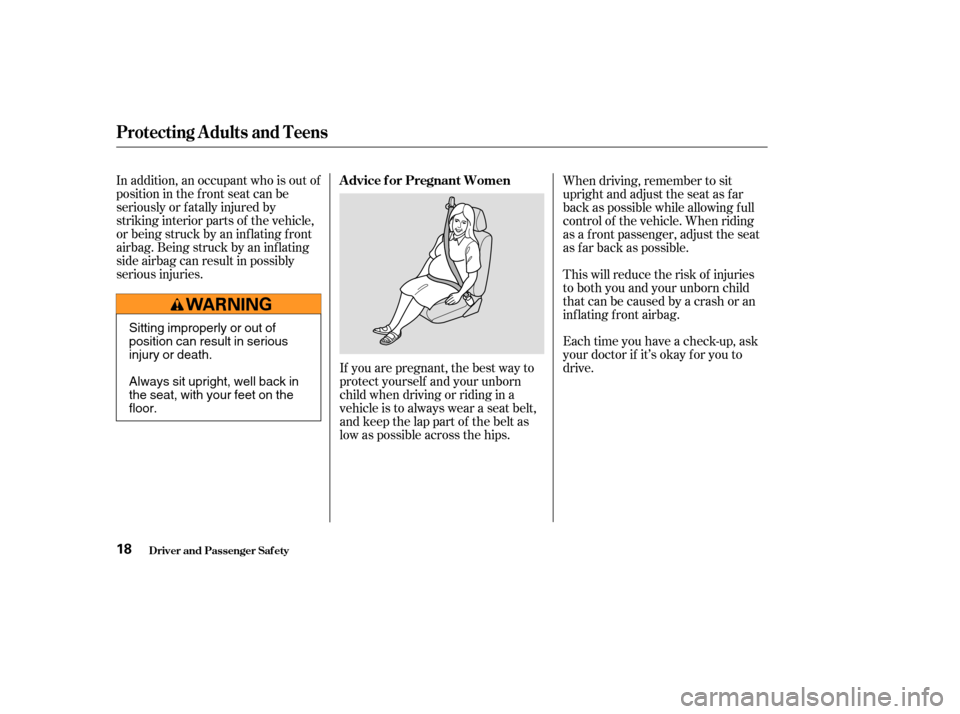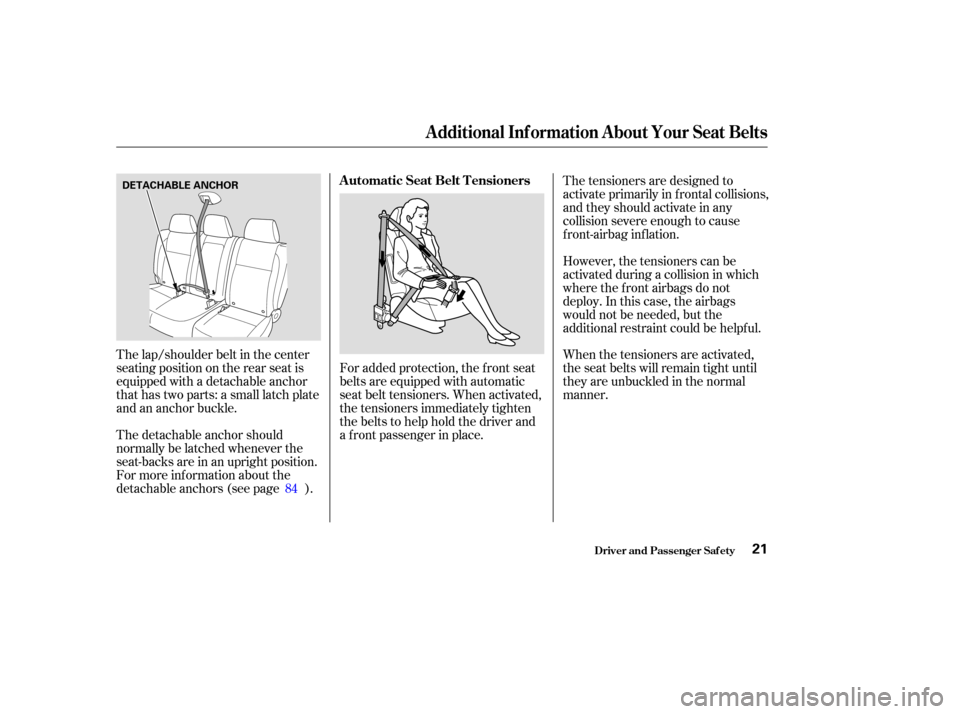Page 18 of 256
Adjust the driver’s seat-back to a
comf ortable, upright position,
leaving ample space between your
chest and the airbag cover in the
center of the steering wheel.
Passengers with adjustable seat-
backs should also adjust their seat-
back to a comf ortable, upright
position.Reclining a seat-back so that the
shoulder part of the belt no longer
rests against the occupant’s chest
reduces the protective capability of
the belt. It also increases the chance
of sliding under the belt in a crash
and being seriously injured. The
farther a seat-back is reclined, the
greater the risk of injury.
See page f or how to adjust seat-
backs.
77
Protecting A dults and Teens
Driver and Passenger Saf ety
Adjust the Seat-Backs
3.
14
Reclining the seat-back too far
can result in serious injury or
death in a crash.
Adjust the seat-back to an
upright position, and sit well
back in the seat.
Page 21 of 256

If a seat belt does not seem to work
as it should, it may not protect the
occupant in a crash.Using a seat
belt that is not working properly can
result in serious injury or death.
Have your Honda dealer check the
belt as soon as possible.
See page f or additional
inf ormation about your seat belts
and how to take care of them. Adjust the steering wheel, if needed,
so that the wheel points toward your
chest, not toward your f ace. This
provides optimal protection f rom the
f ront airbag.
See page f or how to adjust the
steering wheel.After all occupants have adjusted
their seats and put on seat belts, it is
very important that they continue to
sit upright, well back in their seats,
with their feet on the floor, until the
vehicle is parked and the engine is
of f .
Sitting improperly can increase the
chance of injury during a crash. For
example, if an occupant slouches,
lies down, turns sideways, sits
forward, leans forward or sideways,
or puts one or both f eet up, the
chance of injury during a crash is
greatly increased.
20
68
CONT INUED
Protecting A dults and Teens
Driver and Passenger Saf ety
No one should sit in a seat wit h aninoperat ive seat belt .
Adjust the Steering Wheel Maintain a Proper Sitting
Position
6.
7.
17
Page 22 of 256

In addition, an occupant who is out of
position in the f ront seat can be
seriously or f atally injured by
striking interior parts of the vehicle,
or being struck by an inf lating f ront
airbag. Being struck by an inflating
side airbag can result in possibly
serious injuries.If you are pregnant, the best way to
protect yourself and your unborn
child when driving or riding in a
vehicle is to always wear a seat belt,
and keep the lap part of the belt as
low as possible across the hips.When driving, remember to sit
upright and adjust the seat as f ar
back as possible while allowing f ull
control of the vehicle. When riding
as a f ront passenger, adjust the seat
as far back as possible.
This will reduce the risk of injuries
to both you and your unborn child
that can be caused by a crash or an
inflating front airbag.
Each time you have a check-up, ask
your doctor if it’s okay f or you to
drive.
Protecting A dults and Teens
Driver and Passenger Saf ety
Advice f or Pregnant Women
18
Sitting improperly or out of
position can result in serious
injury or death.
Always sit upright, well back in
the seat, with your feet on the
floor.
Page 23 of 256

All passengers
must sit in locked, upright seats
andbeproperlyrestrainedbyseat
belts.
A passenger who is not
wearing a seat belt during a crash
or emergency stop can be thrown
against the inside of the vehicle,
against other occupants, or out of
the vehicle.
If they do, they
could be very seriously injured in a
crash. Objects on
the covers marked ‘‘SRS AIRBAG’’
could interf ere with the proper
operation of the airbags. Or, if the
airbags inflate, the objects could
be propelled inside the vehicle and
hurt someone if the airbags inf late.
If a side airbag
inflates,acupholderorotherhard
object attached on or near the
door could be propelled inside the
vehicle and hurt someone.
If your
hands or arms are close to an
airbag cover, they could be injured
if the front airbag inflates.
Devices intended to improve
occupant comf ort or reposition the
shoulder part of a seat belt can
severely compromise the
protective capability of the seat
belt and increase the chance of
serious injury in a crash.
Carrying hard or sharp
objects on your lap, or driving with
a pipe or other sharp objects in
your mouth, can result in injuries
if your f ront airbag inf lates.
Additional Saf ety Precautions
Never let passengers ride in t he
cargo area or on t op of a f olded-down back seat .
Passengers should not st and up orchange seats while the vehicle ismoving.
T wo people should never use t hesame seat belt . Do not at t ach or place object s on
the f ront airbag covers.
On models wit h side airbags, donot at t ach hard object s on or neara f ront door.
K eep your hands and arms awayf rom t he airbag covers.
Do not put any accessories on seat
belts.
Do not place hard or sharp object sbet ween yourself and a f rontairbag.
Protecting A dults and Teens
Driver and Passenger Saf ety19
Page 25 of 256

The lap/shoulder belt in the center
seating position on the rear seat is
equipped with a detachable anchor
that has two parts: a small latch plate
and an anchor buckle.For added protection, the f ront seat
belts are equipped with automatic
seat belt tensioners. When activated,
the tensioners immediately tighten
the belts to help hold the driver and
a f ront passenger in place.The tensioners are designed to
activate primarily in f rontal collisions,
andtheyshouldactivateinany
collision severe enough to cause
front-airbag inflation.
When the tensioners are activated,
the seat belts will remain tight until
they are unbuckled in the normal
manner. However, the tensioners can be
activated during a collision in which
where the f ront airbags do not
deploy. In this case, the airbags
would not be needed, but the
additional restraint could be helpf ul.
The detachable anchor should
normally be latched whenever the
seat-backs are in an upright position.
For more inf ormation about the
detachable anchors (see page ). 84
Additional Inf ormation About Your Seat Belts
Driver and Passenger Saf ety
A utomatic Seat Belt T ensioners
21
DETACHABLE ANCHOR
Page 27 of 256

Your airbag system includes:one f or the driver and one f or a
f ront passenger. The airbags are
stored in the outer edges of the
seat-backs. Both are marked
‘‘SIDE AIRBAG’’ (see page ). Two SRS (Supplemental Restraint
System) f ront airbags. The driver’s
airbag is stored in the center of
the steering wheel; the f ront
passenger’sairbagisstoredinthe
dashboard. Both are marked ‘‘SRS
AIRBAG.’’
Automatic seat belt tensioners
(see page ).
Sensors that can detect a
moderate to severe frontal impact
or side impact in models equipped
with side airbags. A sophisticated electronic system
that continually monitors and
records inf ormation about the
sensors, the control unit, the
airbag activators, and driver and
frontpassengerseatbeltusewhen
the ignition is in the ON (II)
position.
If you ever have a moderate to
severe f rontal collision, sensors will
detect the vehicle’s rapid
deceleration. If the rate of
deceleration is high enough, the
control unit will instantly inf late the
driver’s and f ront passenger’s f ront
airbags, at the time and with the
f orce needed.
An indicator light on the
instrument panel that alerts you to
a possible problem with your
airbags (see page ).
an indicator light on the
dashboard that alerts you that the
passenger’s side airbag has been
turned of f (see page ).
Emergency backup power in case
your vehicle’s electrical system is
disconnected in a crash.
26
21 28
27
On models equipped with side airbags,
On models equipped with side airbags,
CONT INUED
Airbag System Components How Your Front Airbags Work
Additional Inf ormation About Your Airbags
Driver and Passenger Saf ety23
Page 28 of 256

During a f rontal crash, your seat belt
restrains your lower body and torso,
and the airbag helps protect your
head and chest.
Although both airbags normally
inf late within split second of each
other, it is possible f or only one
airbag to deploy.
This can happen if the severity of a
collision is at the margin, or
threshold, that determines whether
or not the airbags will deploy. In
such cases, the seat belt will provide
suf f icient protection, and the
supplemental protection of f ered by
the airbag would be minimal.Af ter inf lating, the f ront airbags
immediately def late, so they won’t
interf ere with the driver’s visibility,
or the ability to steer or operate
other controls.
The total time for inflation and
def lation is one-tenth of a second, so
f ast that most occupants are not
aware that the airbags deployed until
they see them lying in their laps.
After a crash, you may see what
looks like smoke. This is actually
powder f rom the airbag’s surf ace.
Although the powder is not harmf ul,
people with respiratory problems
mayexperiencesometemporary
discomf ort. If this occurs, get out of
the vehicle as soon as it is saf e to do
so.
Additional Inf ormation About Your Airbags
Driver and Passenger Saf ety24
Page 29 of 256

Your f ront airbags are dual-stage
airbags. This means they have two
inf lation stages that can be ignited
sequentially or simultaneously,
depending on crash severity.
In acrash, both stages
will ignite simultaneously to provide
the quickest and greatest protection.
In a crash, one stage will
ignite first, then the second stage
will ignite a split second later. This
provides longer airbag inf lation time
with a little less force. Your f ront airbags are also dual-
threshold airbags. Airbags with this
f eature have two deployment
thresholds that depend on whether
or not the occupant is wearing a seat
belt.
It the occupant’s belt is
,
the airbag will deploy at the same
threshold as a conventional airbag,
because the occupant would need
additional protection.
If the occupant’s belt , the
airbag will inf late at a slightly higher
threshold, when the airbag would be
needed to supplement the protection
provided by the seat belt.
Dual-Stage A irbags
more severeless severe Dual-T hreshold A irbags
not lat chedis latched
Additional Inf ormation About Your Airbags
Driver and Passenger Saf ety25